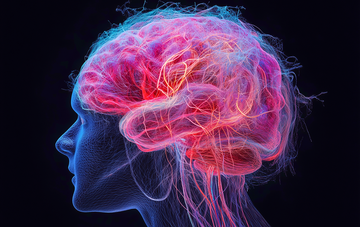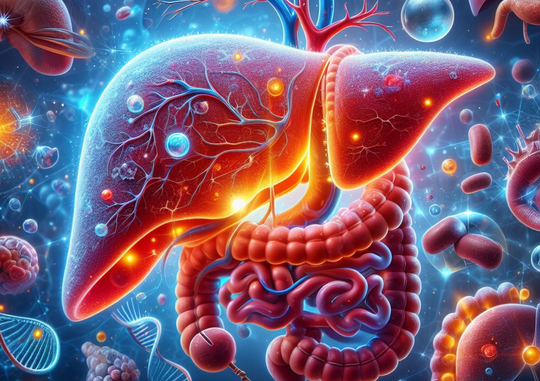Yes, really, "intravenous" light therapy! What's that? Simple: you're giving a portion of your blood circulation a detour, and a device emits different types of light, such as blue, red, and even ultraviolet, into that bloodstream. That blood is subsequently recirculated into your bloodstream.
The effect?
Many different health benefits are available, depending on the type of light used. However, there are generally great benefits for heart and blood vessel health, chronic inflammation, overall health and wellness support, and combating infections.
You can read about the full details in this article, though! Intravenous light therapy has undergone a type of Renaissance in the last decade or so, where it has been repopularized, with good reason! There are some benefits you'll get here that are likely not possible to achieve with regular red light therapy, such as using a panel.
Want to know more?
For the full details, read my entire article below. To learn the basics, read the summary provided below in this article!
Here we go:
"Intravenous light therapy" entails emitting light directly into the bloodstream. This process can be accomplished using lasers, known as "Intravenous Laser Blood Irradiation" (ILBI), or with light-emitting diodes (LEDs). The LEDs, when high-powered, emit light that passes through the skin and enters the bloodstream. With lasers, you'll need to perforate the skin and redirect the bloodstream into a device where the blood is directly treated.
Intravenous light therapy had been largely forgotten for a long time, but over the past decade or so, most Soviet-era and regional research has re-emerged. The main benefits include managing pain, countering heart and blood vessel disease and diabetes, improving overall wellbeing, lowering chronic inflammation associated with many chronic health conditions, boosting immune function, and enhancing circulation.
That's all great.
Different types of light have a slightly different effect. Red light is more healing, while blue and ultraviolet light can be a temporary stressor (especially the latter) and are effective for infection control. More research is generally needed on other wavelengths, such as green and amber.
Side effects, fortunately, are super rare. These include dizziness, headaches, skin reactions because of the injection, and low blood pressure. Of course, any injection should be administered under fully sterile conditions, as improper application can lead to serious side effects.
In the full article, I recommend using the Weber Medical laser under professional supervision if you wish to undergo laser blood irradiation. For LEDs, the story is simpler, as you can use the Endolight, which utilizes a consumer-grade laser on your wrist, or the Kineon MOVE+ Pro, also available in the consumer market. These options enable you to treat the arteries in your wrist and neck, providing most of the benefits of intravenous blood irradiation.
Hopefully, in the future, we'll see more research in this area as it seems like a valuable tool in the toolbox and may offer some benefits (such as for organ function) that may be more difficult to achieve with regular red light therapy. To know for sure, we'll need comparison studies, though!
If you need an introduction to what these terms mean, check the following resources:
- What Is Red Light Therapy?
- Red Light Therapy Explained: Basic Terms Guide
- Start Here - Light Therapy 101 & Buyers Guide
- Red Light Therapy Dosing Chart: The Raw Data From Hundreds Of Studies
- Red Light Therapy Dosing: Why It's Complicated!
- Red Light Therapy Wavelengths Benefits: The Ultimate Guide
- How Often Should You Use Red Light Therapy Explained
These resources should give you a basic understanding of how red light therapy works, and the discussions around it!
The picture at the beginning of this article is AI-generated, though!
What Is Intravenous Light Therapy?
There are numerous names for "intravenous light therapy." One scientific term that's often used is Intravenous Laser Blood Irradiation (ILBI) and "intravascular light therapy." All of these therapies rely on the same principle. Light is introduced directly into the bloodstream via a vein, typically in the arm, because that area is easily accessible.
The issue?
In the past, lasers were the only technology used for this therapy. However, LEDs have made this therapy significantly different. Nowadays, it's possible to emit light into the bloodstream using LEDs, which means you don't necessarily have to perforate the skin.
With lasers, the light is transmitted through a sterile catheter inserted into a vein. That way, you'll illuminate the circulating blood cells and the vessel wall. This process occurs with minimal heating and causes no damage, except for the initial injection.
Curious?
Check a picture of me receiving Intravenous Laser Blood Irradiation at the Health Optimisation Summit 2024 in London:

A nurse applied that light therapy to my vein. Here you can see a fuller perspective:

And, yes, this was a laser application. More on that later. Suffice it to say that with the laser, you can apply different colors of light, such as blue, green, yellow, red, near-infrared, and even ultraviolet (UV) light!
I'll take a deep dive into the benefits of each later in this article...
Additionally, as I've mentioned, LEDs have also been used more recently. I'll provide you with a few examples for that later in this article. First up, let's consider how intravenous light therapy works:
How It Works: The Science Of Intravenous Laser Blood Irradiation Therapy & LEDs
Let's consider the science of intravenous laser blood irradiation, as well as its application with LEDs. Here, I'm using Vladimir Heiskanen's Excel sheet, which contains over 8,000 studies on light therapy (1). Heiskanen has categorized the name "intravascular LLLT" ("intravascular Low-Level Laser Therapy"):

As you can see, there are numerous recent publications on this topic. That's an interesting development, as the benefits of IV laser therapy were already well-researched in the 1970s to 1990s.
The problem? Most of that research was carried out in the USSR. And when the USSR fell, that research, mainly published in Russian, was no longer considered. It was not until the last decade or so that the topic became popular again.
I still clearly remember a device that was launched about 10 years ago, the Quantlet, which relied on this technology. Unfortunately, the device didn't quite live up to its promises; however, improved versions have recently emerged.
But back to the research...
The issue here is that most of the original research is written in Russian. In this case, the only thing I can rely on is the English reviews that analyze and integrate the earlier Russian research (1).
I'll consider reviews here from the last 10 years (2; 3; 4; 5; 6; 7). These reviews do vary widely in their assessment of intravenous light therapy. Some of these reviews are really positive, while others are somewhat more negative. Nevertheless, using these reviews, I can piece together the effects of different mechanisms.
Types Of Intravenous Light Therapy Effects
So let's explore the basics of intravenous light therapy. I'll quote from different reviews here to showcase the effects (2; 3; 4; 5; 6; 7).
First up, a May 2025 review stating the following about the intravenous light's ability for:
"addressing conditions such as cardiovascular disease, diabetic neuropathy, osteoarthritis, spinal cord injury, chronic endometritis, cellulite, and pediatric dental anxiety. [Intravenous laser therapy] demonstrated consistent reductions in pain (30-55 %), inflammatory cytokines (e.g., IL-6, TNF-α), and oxidative stress markers, along with significant improvements in mitochondrial activity and quality-of-life indicators (SF-36, WOMAC). No serious adverse events were reported."
So, intravenous light therapy can have effects on a wide array of health conditions, such as heart disease, the side effects of diabetes, arthritis, and mental health. Intravenous light can consistently alleviate pain and lower inflammation and oxidative stress (which both are harmful in excess). As a result, quality of life improves. And, fortunately, there aren't any serious side effects!
The second review states the following:
"Of these, 19 studies discussed the use of systemic [light therapy] with intravenous application, and 7 studies reported transcutaneous ["through the skin"] application. Regarding clinical studies, 28 studies addressed the application of the techniques in respiratory, cardiovascular, metabolic, neurological, and musculoskeletal conditions. For [animal] studies, 9 articles primarily discussed the application of systemic [light therapy] in pulmonary and musculoskeletal conditions. Despite the promising results, methodological limitations, and variabilities in studies on systemic laser [light therapy] prevent the categorical assertion of its efficacy" (3).
Once again, this review demonstrates health benefits across the board, but also acknowledges that significantly more high-quality research is needed.
Additionally, there is a study on intravenous light therapy for dental applications. I've written extensively about red light therapy and oral health, and I think it's a game-changer in the field. Here's the outcome of intravenous light therapy, specifically, however, which is more skeptical:
"The outcomes were periodontal parameters and glycemic control in patients with periodontitis and type II diabetes, anxiety control in pediatric dentistry, postoperative pain after third molar extraction and improving taste in post-COVID-19 patients. [...] The current evidence does not overwhelmingly support the effectiveness of modified-[intravenous laser therapy] in controlling oral and/or systemic conditions in dentistry." (4).
Therefore, further research is needed in this area. The main issue here is that only five studies were published on various topics, including anxiety associated with dental visits and molar extractions. A lot more research is needed in general to draw stronger conclusions, but it doesn't mean that intravenous light therapy doesn't work!
Then, a very interesting review study from 2020. Researchers write here that:
"After applying the inclusion and exclusion criteria, 13 articles were selected. Coronary diseases were the most prevalent, followed by type 2 diabetes mellitus, with the coronary artery being the most widely used access route for ILIB [or "intravascular laser irradiation of blood"] application. Despite the varied parameters and protocols for using this kind of therapy, all studies have shown satisfactory results in the patients' clinical condition. ILIB proved to be effective in all organic systems, showing some positive result. However, studies on the effect of this therapy on various diseases are still scarce in the literature, and there is a need for more well-designed clinical trials to better understand the role of ILIB in various systemic diseases." (5).
So, once again, there are arguably benefits for many different chronic health conditions, except perhaps cancer and neurodegeneration, because these haven't been studied in detail in relation to light therapy as far as I know. But for diabetes, pain, and blood and heart vessel disease, there's ample positive evidence!
A somewhat earlier 2015 review study examined the application of red light specifically at 630 - 640 nm (6). As far as I can tell, that wavelength is also the most frequently studied in the field currently. I'll consider that study in more detail below when I dig deeper into wavelengths.
Lastly, there is one more 2024 review on red light therapy for inflammation, which is linked to many chronic health conditions. Here, researchers write:
" An increase in anti-inflammatory cytokines, a decrease in pro-inflammatory cytokines[, which are messenger compounds], and an increase in [Nitric Oxide which dilate blood vessels] can be observed. The wavelengths used ranged from 660 to 808 nm when using a low intensity laser and when using a VIP light source 480-3400 nm, they also differed in terms of the light emission pattern. [Intravascular laser irradiation of blood] may be a complementary treatment option for patients who have comorbidities that lead to systemic inflammation." (7).
Once again, a great outcome. So intravenous light therapy can be directly used to counter inflammation!
Next up, let's consider some precise effects of red light specifically:
Different Wavelengths Of Intravenous Light Therapy And Their Effects
Here I'll say something explictly about different wavelengths of light that are used intravenously.
(I've written very extensively about the effects of varying light therapy wavelengths in the past!)
Intravenous Red Light (630 - 640 nm)
Fortunately, we've got a full free text of the article on intravenous red light (8). The review, from 2015, spans the previous 30 years of intravenous photobiomodulation, also known as "red light therapy" (8).
First of all, intravenous red light alters the structure of your blood. The number of red blood cells is increased, for instance, and the activity of white blood cells (for your immune system) improves. The "erythrocyte sedimentation rate", which measures how quickly red blood cells fall to the bottom in a tube, also improves. In the bone marrow, moreover, the intravenous red light helps create new immune cells and mobilize these into the body (8).
Overall energy production is even altered by changing the carbohydrate metabolism in your body. And, with intravenous red light, you'll have anticoagulant properties, which may prevent adverse outcomes for your heart and blood vessel health, such as strokes. The platelets will aggregate ("clump together") less, and the viscosity improves. Also, blood circulation in your extremities is enhanced. And, overal,l metabolism is improved, meaning that repair mechanisms work better.
So, heart and blood vessel health improves across the board with the 630 nm range (8). Many organ systems besides the heart and blood vessels are affected, however. These include the lymphatic, nervous, hormonal, and immune systems (8). The heart and blood vessel system have the best evidence base, however, right now.
Here's a great quote on the all-around benefits of emitting red light directly into the bloodstream (I've removed the references for readability) (8):
The studies and accumulated literature of more than 30 years have proved that the visible red light in the waveband of 630–640 nm have a powerful influence on:
oxygen
blood cells
blood enzymes
the
blood proteins
blood coagulation system
biological fluids
vascular wall and microcirculation
neomicrovascularization and neoangiogenesis [the creation of new blood vessels, roughly!]
positive effects seen in the treatment of cardiovascular diseases and myocardial ischemia ]
vascular diseases
The same visible red waveband has also demonstrated proven effects on the various systems which contribute to the organism's survival:
lymphatic system
nervous system
neuro-endocrine system
immune system
Keep in mind that that conclusion is supported by 100+ scientific references, mainly from the Russian literature!
Let's move on:
Intravenous Blue Light
There's tons of online content available on blue light intravenous therapy. However, the significant issue here, for me, is that most of the claims lack supporting evidence.
Heiskanen does list a few studies on blue light, however (1). Both are studies in people with diabetes (9; 10). Surprisingly, against my expectations, the intravenous blue light lowers blood sugar (9). This effect is similar to the effects of red light (10).
Some other online claims are that blue light:
- Can help release Nitric Oxide (NO), which helps dilate blood vessels and circulation
- May boost energy production in the mitochondria (your body's "energy factories")
- Counters bacteria specifically and infections. Here, the theory posits that blue light generates oxidative stress, which subsequently kills bacteria and other organisms.
- Boosts wound healing and stimulates the immune system. This effect is generally accepted outside the body, however, so it's not too speculative that this effect occurs when blue light is directly shone into your bloodstream! Check my article on blue light therapy for more information.
My viewpoint here? There is some preliminary evidence, but even the Russian studies mostly mention red light and not blue. So far, I'd say that the 630 - 640 nm red wavelength range is best supported by the evidence.
And, there's another part of the light spectrum that also has excellent support:
Ultraviolet Blood Irradiation Therapy
Yes, really, we're talking about UV light blood therapy, so the type of light that can give you sunburns and gives you that extremely nice summer tan! The good thing? There are some excellent sources here, especially Professor Michael Hamblin's article with the title "Ultraviolet Irradiation of Blood: "The Cure That Time Forgot"?" (11; 12).
We've interviewed Prof Hamblin before - the founder and owner of this website - interviews Prof Hamblin here:
But let's consider the very important message on ultraviolet blood irradiation (12). What's interesting here is that Hamblin opens his paper with the statement that ultraviolet blood irradiation has been used since the 1940s and 50s! But with the onset of antibiotics, ultraviolet blood irradiation has largely been forgotten.
And yet, countering infections is precisely one of the primary uses of the therapy. If you wish to read the extremely rich history here of this intervention, check the full text of the article (12).
Here's a quote on early animal studies using ultraviolet blood irradiation:
"Knott and co-workers then carried out a series of experiments using UV irradiation of blood extracted from dogs that had been intravenously infected with Staphylococcus aureus bacteria and hemolytic Streptococcus species, and then the treated blood was reinfused into the dogs. They found that it was unnecessary to deliver a sufficient exposure of UV light to the blood to directory kill all the bacteria in the circulation. It was also found unnecessary to expose the total blood volume in the dogs. The optimum amount of blood to be irradiated was determined to be only 5–7% of the estimated blood volume or approximately 3.5 mL per kg of body weight." (12).
So, the blood of the dogs was infected but by just irradiating a small part of the blood (often with very low power), the infections were countered. Then, in the 1920s, the therapy started to be used on humans.
The technology was then further developed in the 1930s to the 1950s. You may be aware that ultraviolet light is also used to sterilize surfaces or other objects, for example, the use of UV in swimming pools to remove pathogens.
Intravenous ultraviolet light therapy works similarly, but with slight differences. There are many other mechanisms of action at play, and "sterilization" would be an oversimplification (12).
Very low doses of ultraviolet light, which is almost always used in intravenous application with all light types, can have a so-called "hormetic" effect. Hormesis refers to a temporary stressor that ultimately leads to enhanced health in the organism. Exercise and cold therapy are examples of hormesis. But, in this case, the blood itself is the end goal of that hormetic adaptation.
Ultraviolet intravenous irradiation affects the blood, for instance, such as the exchange of ions. And, there are effects on white blood cells, such as an increase in oxidative stress that leads to better health (similar to exercise!). Both red and white blood cells are affected in various ways, resulting in lower inflammation, a more effective immune system, and an enhanced antioxidant response.
It's usually UVA, such as 365 nm light, that's used here. In the future, this modality may be used to counter antibiotic-resistant bacteria, for instance, while minimizing side effects.
Furthermore, more new research is needed in this area. So I don't want to draw any firm conclusions here. Before using ultraviolet blood irradiation, I'd like to see more high-quality modern research before I could recommend it. Therefore, for now, and due to the lack of current studies, I don't recommend using ultraviolet blood irradiation without medical supervision.
Claimed Benefits & Potential Applications
There are lots of other claims on what intravenous irradiation can achieve. Examples here are:
- Osteoarthritis
- Fibromyalgia
- Sports and joint & bone injuries
- Stroke and other neurological or brain issues
- Cognitive function
- Peripheral circulation problems, of the extremities - hands and feet in particular
- High cholesterol levels and obesity
- Viral infections - although, as stated before, ultraviolet and blue light do counter infections in general!
Many of these claims currently lack sufficient evidence, I think. You can find studies here and there on the effects, but these aren't well-established. The same is true for green and yellow/amber light intravenous light therapy - I can find a study here and there on the topic, but I'd like to see more research before recommending it.
That doesn't mean this profile won't change in the future. On the contrary, because there is so little research on intravenous blood irradiation, especially in the West, I believe you'll discover many new use cases in the future.
So that's great...
What Studies Say About Side Effects
Generally, the side effects are extremely mild here. The reviews I've quoted above confirm that. You may have some slight side effects such as:
- Feeling dizzy, or nausea, or a headache. I actually had that dizziness side effect when I used intravenous light therapy during HOS 2024! These effects will generally subside once you discontinue treatment or shortly afterwards. Discuss this with your physician if you would like more information. Some of these effects can occur due to your blood vessels opening up, for instance, which can cause headaches.
- Lower blood pressure. This really depends on the person. If you already have high blood pressure, the effects are likely to be exclusively positive. But if you've got a systolic and diastolic (upper and lower) pressure of 100 and 75, for instance, then further lowering it may cause a rare problem! Again, keep in mind that the effects are generally mild, and you can stop your session if any side effects occur. So, monitor your feelings closely.
- Local reactions - this is the case because an injection is required. This is the same slight side effect that people experience when they're injected with hormones or a vaccine, etc. There may be slight bruising or redness at the injection site.
- This is a bit of common sense, but if you use injections, ensure that the process and the locations are sterile. This is a no-brainer, but I wanted to mention it nonetheless. If you don't know what you're doing here, or aren't trained to give injections, then don't do it - or at the very least get educated first!
- Generally, though, intravenous light therapy should be extremely safe. If you want to err on the side of caution, use the visible colors of the spectrum, such as red, blue, green, yellow, etc! As stated before, only use the ultraviolet light application after talking to your doctor. The key here is understanding that blue light, and especially ultraviolet light, can interact with infections that may be present but don't currently cause any side effects.
Who Might Consider IV Light Therapy? Risks And Controversies
In my opinion, almost anyone can try intravenous light therapy. I've got friends, such as my dentist friend Dr. Ana Paula Tanko, who uses intravenous red light with all of her patients in her clinic, for instance, before treatment in a separate room. That intravenous light treatment helps patients feel better, reduces inflammation, and improves blood circulation.
In general, with chronic conditions, it may be more useful to apply intravenous light therapy. But, as you've seen earlier, there are a few really well-proven indications for intravenous light therapy, such as heart disease, diabetes, circulation problems, chronic inflammation due to health conditions, and more.
So in these cases, I'd definitely recommend intravenous light therapy! I do recommend going slow at first, though, to ensure you don't have any side effects. Again, side effects are super rare, but they do happen. And, because you're directly irradiating the blood, the risk of side effects may be slightly higher than when you're using a panel, for instance.
All in all, the intravenous laser blood irradiation side effects are thus infrequent if the therapy is used correctly!
Next up, let's consider where to get intravenous light therapy:
Where Is Intravenous Light Therapy Available?
I've actually got three consumer products that are recommended to be used for intravenous light therapy.
The first is the true intravenous light therapy, where you need to perforate the skin and redirect the blood flow so it can be irradiated. This is the Weber medical intravenous laser:

Again, you can see the nurse applying this therapy to me here, with the exact device shown above:

For most people, however, this is arguably not a viable solution! First, you'd need to be able to inject yourself properly. And second, the device is on the more expensive side.
You can grab an Weber Medical Endolight Laser and mention Alex Fergus for a potential discount. That intravenous laser is generally only targeted towards medical professionals, though.
The solution here?
Well, there's a more straightforward solution! The Weber Endolight, which has been reviewed by Alex Fergus - the owner and founder of this website - emits five different wavelengths and treats the blood flow at the location of your wrist, where the skin is really thin:
And because the power output is quite high, sufficient light should be penetrating so that the blood flow of your body is directly treated!
If you want a Weber Endolight, use the discount code ALEX and the following link.
Then there's an even more exciting option...
That's right, using the Kineon MOVE+ Pro around your neck. You can see that device being used at the two arteries around the neck in the video HERE. Kineon does directly advertise with that use case on their website, and I also agree that this is safe to do!
Want to know more? Check the review by Alex Fergus below:
Yes, that device is mainly targeted towards joint health. However, it can also be used for intravenous irradiation. And because it's directly placed against the skin, it's an excellent method to stimulate blood flow to the brain directly.
How?
You should be able to feel the Carotid arteries with your pointer and middle finger in your neck, where you should be able to feel a heartbeat. Then, simply place the Kineon MOVE+ Pro on that Carotid artery, and you should see an effect. It's okay if the MOVE+ presses slightly into your skin, as that helps the penetration of the red and near-infrared light into the bloodstream.
You can see the Carotid arteries here:

Easy peasy!
If you want to get a Move+ Pro from Kineon, use discount code AFERGUSMOVE+ for 10% off and the following link.
What To Expect?
The answer here is straightforward. You'll feel the effects that light therapy generally has on you, maybe with some slight variation. Examples include feeling more energetic or fatigued, improved blood flow, greater relaxation and well-being, and deeper sleep at night.
Additionally, the effects of lower (chronic) inflammation and oxidative stress are expected to improve overall health. The most noticeable effects, however, I've heard from companies such as Weber, which I talked about earlier, are if you apply this therapy more frequently.
Examples include treating yourself once a week for 12 weeks, for instance. Of course, with the regular intravenous light therapy, that's going to be more difficult.
Another effect I've heard, from the CEO of Kineon, is that he no longer gets sick when he uses the MOVE+ at his carotid artery. This is despite having young children, extensive international travel, and a very stressful lifestyle.
So, yeah, don't expect magic...
But, expect the effects of general health improvement. These effects may result in less pain that you feel with a condition such as fibromyalgia, for instance. Alternatively, your varicose veins may not be as much of an issue as they otherwise would be. Or your back pain or knee pain may be reduced by 30 - 40 %. It's hard to put a universal rule on this - but you get the idea!
Things should get better...
Let's finally conclude:
Conclusion: Hopefully, We'll Soon See Much More Research On This Topic!
So far, so good! It's wonderful that the Russian research on intravenous light therapy reentered the scientific discussion!
And yes, the effects of blue, red, and ultraviolet light are already promising. Over time, particularly with the publication of additional articles, I'll update this article to include additional wavelengths, such as yellow (approximately 570-590 nm) and green (500-570 nm).
The number of publications on this topic is rapidly expanded over the last decade. Currently, however, it's a therapy that I highly recommend you try, especially if you already have a device to easily apply blood irradiation, such as the Kineon MOVE+ PRO!
Items Mentioned
- For a Move+ Pro from Kineon, use discount code AFERGUSMOVE+ for 10% off and the following link.
- For a Weber Endolight, use discount code ALEX and the following link.
This is a post by Bart Wolbers of Lighttherapyinsiders. Bart finished degrees in Physical Therapy (B), Philosophy (BA and MA), Philosophy of Science and Technology (MS - with distinction), and Clinical Health Science (MS), has had training in functional medicine, and is currently chief science writer.
Found This Interesting? Then You Might Like:
- Discount Codes, Deals & Recommendations - Red Light Therapy
- Red Light Therapy For Weight Loss: The Science Of Supercharging Fat Loss
- 36 Powerful Red Light Therapy Benefits
- How To Use Red Light Therapy 101: The Best Guide For Starters
- The Red Light Therapy Facial Fat Loss Link: Myth Or Reality?
- The Impact Of Red Light Therapy On The Lymphatic System
- Red Light Therapy For Sleep: The Science Of Sweet Dreams









